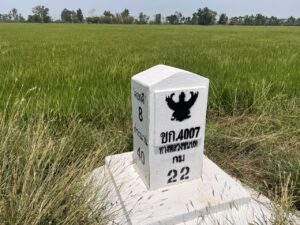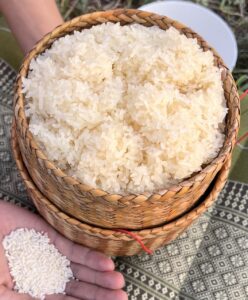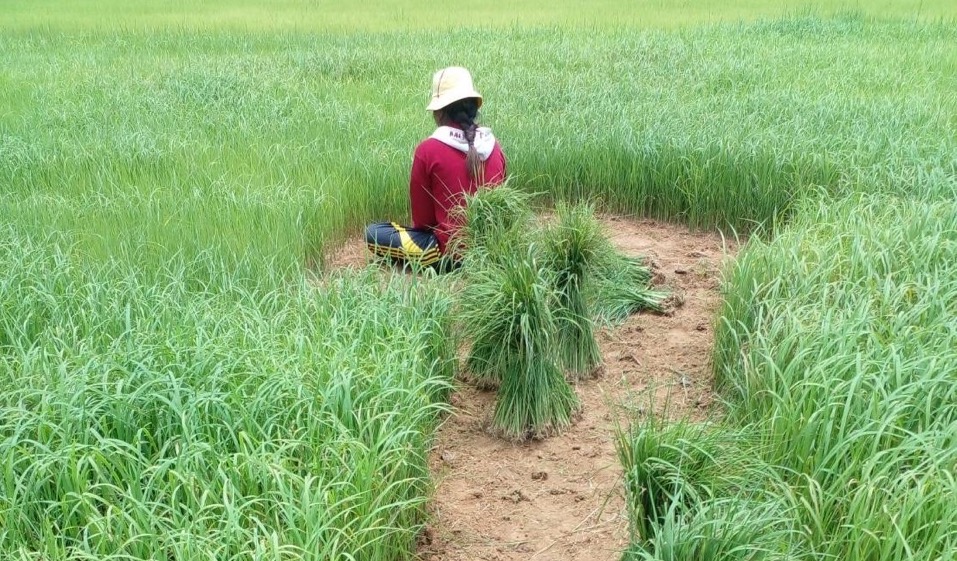(BAN NONG SONG HONG, KHON KAEN, Thailand) — Just as dawn illuminates dusty rice patties in eastern Thailand, an elderly woman, Yai, and a toddler, Taan, emerge from the dark into a dirt-floor living space that doubles as a kitchen.
Their modest home is about the size of a few American parking spaces. Using a standalone gas burner atop a stump, Yai starts a fire to cook breakfast with rice — a timeless ingredient that feeds and fuels life in this tiny village as it has for centuries.
“Gin khow luk,” says Yai as Taan runs circles around the living space, “Eat rice, child.”

Taan and Yai at breakfast. Credit: Wes Sprouse
Taan’s family, like many in the village and for miles in every direction, are rice farmers. They grow rice for subsistence and income.
While Taan’s family may have enough to feed themselves, rice isn’t enough to live on. So, to make ends meet, men and women in their village move off the farm for better pay and quality of life while they support their families’ farm back home.
This practice leaves fewer hands to cultivate rice. Men and women over 50 are more likely to be found in the rice fields of Khon Kean than their younger counterparts.
“There are no jobs with a basic or regular salary,” says Taan’s mother, Sirinan “Nook” Sirikate.
She works in Bangkok with her husband and sends money home for Taan, seeing Taan on long weekends and holidays.
Counting the Cost
Rice cultivation in this area is generally possible only once a year from May to late October. Although the crop is vital to life and prosperity in the village, it doesn’t often deliver on the latter’s promise.
On average, rice farmers cultivate two to four acres of land for rice. That’s a sizable investment in labor, fertilizer, insecticides, and hiring farmhands, tractors, or plows to manage the soil.
“In many cases, they are seeing negative returns,” says agricultural studies expert Prof. Jinsan Sanitchon of Khon Kaen University’s College of Agriculture.
The production cost for Thai farmers in 2022 was 5,898.5 baht per rai, which increased by 2,058.8 baht per rai compared to 2012 when the production cost was 3,839.7 baht per rai,” said Bangkok Post, an English language paper in Thailand since 1947.
In 2022, Thai farmers earned 3,900 baht per rai, versus 4,678 baht per rai in 2012. This leaves the average Thai farmer with a loss of around 2000 baht per rai in 2022.
In September 2023, Thailand approved a $908 million plan to suspend farmers’ debts for 3 years. Thailand has already spent billions on farm subsidies, which critics called handouts.
Now, farmers lease their ancestral land from someone else, marking just the beginning of the cost considerations.
The most important resource for growing is the most unpredictable and expensive: water. Most farmers in Khon Kaen need rain to fill their rice patties. Irrigation systems are rare, and water management is not a widely practiced government effort.

Planting rice seedlings is not possible here until the first rains have softened the soil. [Credit: Wes Sprouse]
Origins of the trend
Since the early 1960s, men and women from family farms have been moving to major cities to supplement farming income. This aspect of family farming in Thailand is so commonplace that it’s become a part of the culture.
Village sons and daughters move to major cities in Thailand, like Bangkok or elsewhere, to find well-paying jobs and send money back to their families in Khon Kaen.
One resident, Win Onsiri, says he remembers villagers leaving the village this way since he was a child. He’s 85.
“My father was the village boss; he made 100 baht per month, and that was a lot at the time,” says Win. Still, opportunity is limited in the village, so it’s no surprise the trend has not already exhausted itself.
Popular for decades, absentee farming has had negative impacts. Rice cultivation is labor intensive and requires experience and attention. Since the growing season is only once a year, family farmers typically only practice farming 20-30 days a year.
Even then, time spent on crops is low, and that’s where the problem begins. Thailand’s neighboring farmers, like in Vietnam, are full-time rice farmers. The lack of ‘intensiveness,’ Sanitchon calls it, may be costing farmers their future.
Facing the Reality
In February, Thailand’s Commerce Ministry announced that rice exports would be down over 14% due to lower production and increased competition. Two months later, according to NASDAQ, first-quarter results show that rice exports beat expectations by 23%.
The surge in production came after higher rice prices sent more profits to farmers. Higher prices due to self-imposed export restrictions by Thailand’s two biggest rice export competitors, India and Vietnam.
That’s raising hopes for locals who believe the trend will continue.
Even so, Sanitchon says families can not subsist solely on farming rice. So, the question is, why do they continue to try? He said because they aren’t growing rice, they are planting food security for a year, and hope for extra agricultural income.
Sanitchon says a lack of an independent spirit, reluctance to invest in technology or mechanization, and government subsidies are “taking the incentive out of farmers to advance.”
A better way?
Two hours away, Yai, Taan, and other villagers from Nong Song Hong are heading to Ban Rak Chat, a village in the same province, just about twenty kilometers northeast of Khon Kaen City, for a wedding.
Everyone is surprised when they look out the window. They pass rice fields that are well irrigated, although the rainy season has yet to come.
With access to irrigation canals, farmers in this part of Thailand can harvest rice two times a year instead of once, like elsewhere in Khon Kaen, where there are no irrigation canals.
Irrigation allows rice farmers to grow twice a year. It also helps reduce the cost of pesticides, drowning out weeds without using pesticides or other toxic chemicals to battle unwanted plants and bugs. Those pesticides rob farmers of better yields and precious baht.

Rare area of Khon Kaen, Thailand where rice is grown twice a year. [Credit: Wes Sprouse]
In Nong Song Hong, wedding participants, such as ring bearers, customarily receive monetary gifts from the bride and groom. One attendee groused, “They have more but give less, and we have less but give more.”
The real advantage is that Baan Rak Chat farmers are more familiar with farming best practices and costs because they are farming twice as much. This family isn’t planning on farming just yet, the groom is in the air conditioning business, which is as good as working in the oil business in Thailand.
Seeds of change
Anchita Sansira, a tax assessor in the Na Ngan Subdistrict office, administers Ban Nong Song Hong. She says that when villagers have a verifiable salary, they have typically leveraged it for debt like educational loans for their children, cars, and, last on her list, farm equipment.
Like many here, Nook wants a better life for Taan too, but she isn’t planning to finance her future for it.
“I want to have a car, clothes, and a good school for Taan. We only plan to do this for a few more years to pay for our truck, and then we will move back here,” she says. adding “when we have enough money,”
She means that when they move back, they’ll have an advantage.
Increasingly, there are signs that a new generation doesn’t want to be responsible for a past they had no part in shaping, and cultural upheaval is forcing Thailand to face the expectations they have today.

Rice is the lifeblood of Thailand.
[Credit: Wes Sprouse]
They are making their historical mark on society too.
In 2020, thousands protested in Bangkok for democratic freedoms and equal rights, landing dozens of teenagers in prison, and the matter isn’t settled. One man is serving 50 years for defaming the king and the government. Many other factors are contributing to a new mindset for Thai citizens writ large that’s clearly one of self-determination.
That begs the question, what will happen when the current laborers are no more, and the rice is still needed in markets? Who’s going to take their place, and why would anyone farm a commodity for negative returns, let alone subject themselves to devastating poverty?
In a word, Sanitchon calls it “agri-culture.” Rice is not grown for income but for food security. They have to grow it, and they will always grow it, it is their culture.


